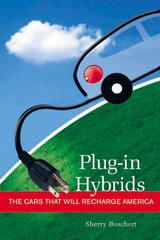The notion of the plug-in hybrid revived the hope of plugging in. I made my peace with the notion of a transition vehicle, with a plug and an engine. GM announced the Volt.
Then a couple of years ago Carlos Ghosn had some sort of epiphany and announced Nissan's belief in the inevitable electrification of cars, and Nissan's intention to lead the transition. He defied conventional thinking by moving directly toward the commercialization of all-electric cars. Hundreds of thousands of Nissan all-electric cars would be manufactured in Asia, America and Europe within a very few years.
I was thrilled. Consumers would soon begin to have a choice of vehicle types that include real electric cars. The marketplace, rather than bureaucrats and academics, would decide whether EVs have a place.
Government and industry began to plan for the rollout of plug-in cars with a plan to roll out public charging infrastructure. Level II charging stations are great for opportunity charging while shopping or working and should be widely diffused. But there wasn't much discussion about faster charging options, as it entails additional obstacles of cost and lack of standards and a presumption that cars wouldn't be fast-charge enabled. Although I knew it was technically feasible, it seemed we would have to wait. Although fast charging stations could enable long distance EV driving and are one way to meet the needs of urban purchasers of EVs who don't have parking with access to electricity, it is logically not a matter of first priority.But just as I was pleasantly surprised to find Nissan's LEAF in the offing, so too fast charging is going to appear more rapidly than expected. The DOE grant to the Etec EV Project will put 260 Level III chargers in the ground in the next two years. Nissan's LEAF will initially appear with a fast charge connector, something that will surely be a purchase option in the future. (And is some compensation for the slow 3.3kW Level II charger in the first cars.) The iMiev, should Mitsubishi do an American release, also has a fast charge connector. And Th!nk announced intentions to enable fast-charging in its cars in an agreement with Aerovironment.
Once again, I celebrate that consumers will have options as we work our way toward the best solutions for quick charging. Better Place has pushed its proposed solution to the range dilemna - battery swap stations. One car maker, Renault, is making cars to spec, and BP has demonstrated the battery swap device in Japan. Swapping out an empty pack for a full one is enticing. It's proven to be enticing to the tune of hundreds of millions of dollars. If swap stations can be commercialized and the batteries can be charged at Level II speeds and below, they too might offer benefits and be part of the clean transportation quilt. But essentially off the shelf Level III fast charge stations, capable of delivering near-to-full charges in under 30 minutes, can be put in service within months. A Level III fast charger can be installed for about $100,000, compared to millions for a hydrogen station and perhaps $1 million for a battery swap station.
Which finally brings me to the fast charger I saw the other day in Vacaville, CA. Installed by PG&E with funding from the State, it sits beneath a solar PV array amongst a handful of Level II chargers, including small paddles for RAV4 EVs, AVCONs for RangerEVs, and aTesla charge station. The fast charger uses a Japanese connector (an American standard remains under consideration) which was easy to handle. I wish I had gotten a photo of the complete line-up of chargers under the solar array, because it is evidence of real-world solutions, available now, to make plug-in cars and renewable electricity a reality quickly.



5 comments:
A happy day
ghghg
I love to travel everywhere, my car is a wonderful tool for me. when i was to costarica i saw costa rica homes for sale by internet and i liked too much.
Well to be honest I prefer the electric car, is more expensive as compared to conventional internal combustion engine vehicles and hybrid electric vehicles due to the additional cost of their lithium-ion battery pack. 23jj
Post a Comment